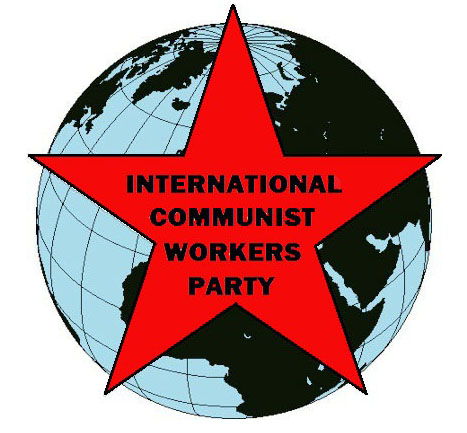
 |
FIGHT FOR COMMUNISM! |
International Communist Workers Party | |

In Part I (here), we saw the political line of the Communist International (CI) that communists in colonial countries must ally with capitalists and fight for "bourgeois democracy". This idea was taken over from the political program that the Bolshevik party had developed long before their revolution of October 1917.
That program was based on the assumption that in countries where capitalism was less developed, the masses could not succeed in a fight for communism or even socialism. Even socialism was claimed to need a large working class and a strong industrial base. Instead of communism, the masses were supposed to put up with capitalism until the working class grew larger and the capitalist economy developed further.
Lenin said that if the capitalists of a country that did not yet have a "bourgeois-democratic" government were willing to fight for one, the workers should to ally with them. They should "deal joint 'blows' at the enemy, shoulder to shoulder with the revolutionary bourgeois democrats."[Note 1] While allying with capitalists, the working class was supposed to fight for the leading role in the movement, the so-called "hegemony of the proletariat."[Note 2] This was to allow turning the fight for bourgeois democracy into a fight for socialism.
The CI applied this line specifically to countries dominated by imperialism. It claimed that workers had at least temporary common interests with "their" capitalists, one of the central ideas of nationalism. Applying this wrong analysis, the CI often made it worse by underestimating potential political activism of the worker and peasant masses in colonized countries like India and China.
In India, for example, there were quite a few industrial workers even before WWI, in textiles, jute mills, coal mining, etc.[Note 3] These workers organized strikes, including a big political strike in 1908 and a series of big strikes in 1920 and 1921. Although the majority of Indians were peasants, about a quarter of the agricultural population were workers by the 1920s.[Note 4] Peasants fought violent battles against landlords and British rule. The revolt in Malabar against landlords and the British army in 1921, for example, led to about 60,000 arrests and 10,000 causalities.[Note 5] A large section of the Indian masses was capable of fighting against capitalism if a communist party led them.
Although the Bolshevik's nationalistic position on allying with capitalists remained the dominant one, it was often challenged by communist activists. Indian communist M. N. Roy argued against Lenin at the 2nd CI Congress in 1920. He said that the CI should not support the "bourgeois-democratic movement in Eastern countries," and in India it should "assist exclusively the formation of the communist movement in India" and "concentrate on organizing the broad masses for the struggle" for their interests.[Note 6] Comrades from Italy and Iran said that national movements that included capitalists were simply not revolutionary. Serrati of Italy argued that alliances with capitalists undermined working class consciousness. In fact allying with capitalists always means suppressing or watering down communist politics and promoting nationalism.
The CI continued to support capitalist movements, however, especially in China. When M. M. Borodin was sent to China as a CI representative, his orders said that he was to "act in the interests of the national liberation movement in China and not to concentrate on implanting communism in China." [Note 8]
Borodin developed a close relationship with Sun Yat-Sen, leader of the nationalist Guomindang (GMD). Borodin supplied CI money, arms and organizational advice to the GMD and urged communists to join it. In April 1927, Chang Kai-shek led the GMD against the communists, massacring communist supporters in Shanghai and other cities. About 300,000 communists and their supporters were murdered over the next year,[Note 9] and the communist movement has nearly wiped out by the GMD attacks.
This enormous defeat should have led to the rejection of worker alliances with capitalists in colonies, but it didn't. Why not? The Bolsheviks were convinced that their own revolution had succeeded by following the line they wanted to apply in China and India. This was in fact a very distorted analysis of their own history. They also bought into the idea that industry must be much better developed in India or China for the dictatorship of the proletariat to succeed there. This was contradicted by the Bolsheviks own experience of revolution in relatively backward Russia. The clearest evidence of the impossibility of a nationalist strategy to destroy capitalism-imperialism and establish communism was to come later, however, with the failure of all of the "national liberation" movements of the 1950s, '60s and '70s. We will discuss these movements later in this series.
[Note 1] V. I. Lenin, "Social Democracy and the Provisional Revolutionary Government," (1904) Collected Works, Moscow, 1965, vol. 8, p. 289.
[Note 2] V. I. Lenin, "Revolution and Counter-Revolution," (1907) Collected Works, Moscow, 1965, vol. 13, p. 115.
[Note 3] V. I. Pavlov, The Indian Capitalist Class: A Historical Study, New Delhi, 1999, pp. 176-186.
[Note 4] Irfan Habib, The Indian Economy 1858 – 1914, New Delhi, 2006, p. 71.
[Note 5] K. N. Panikkar, "Peasant Resistance and Revolts in Malibar," in Colonialism, Culture and Resistance: Collected Essays, New Delhi, 2007, pp. 227 – 250.
[Note 6] Quoted in A. B. Reznikov, "The strategy and tactics of the Communist International in the national and colonial questions," in R. A. Ulyanovsky, The Comintern and the East: The Struggle for the Leninist Strategy in National Liberation Movements, Moscow, 1979, p. 147.
[Note 7] A. I. Sobolev, et. al., Outline History of the Communist International, Moscow, 1971, p. 87.
[Note 8] Quoted in Reznikov, p. 162.
[Note 9] Barbara Barnouin and Changgen Yu, Zhou Enlai: A Political Life, Hong Kong, 2006, p. 38.